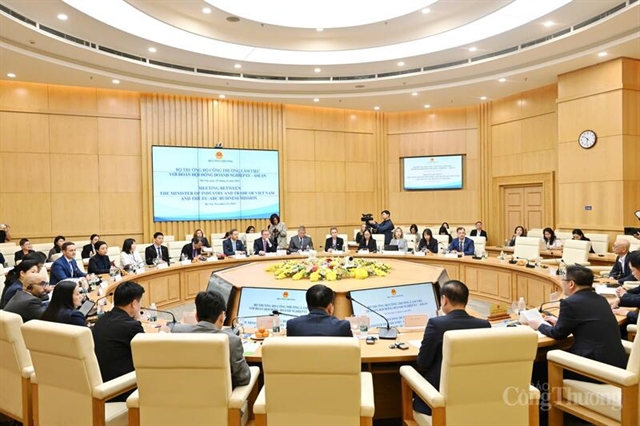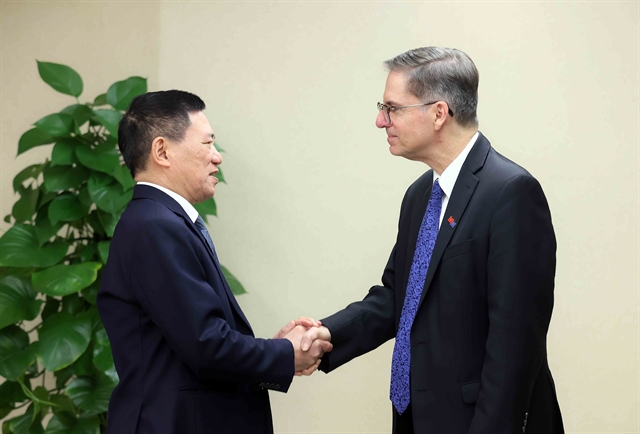 Economy
Economy


|
| An investor tracking the market's movement on the trading floor of a securities firm in Hà Nội. — Photo bnews.vn |
HÀ NỘI — Vietnamese equity mutual funds have swung into positive territory amid the VN-Index’s recent recovery.
After bottoming out in early April, the benchmark index reclaimed all losses incurred during the tariff-triggered volatility by the end of May. The rebound has buoyed equity funds, restoring previously negative returns to solid profits.
Between April 10 and May 31, several open-ended equity funds delivered substantial returns.
Notably, DC Dynamic Securities Fund (DCDS) yielded 26.4 per cent, Viet Capital Discovery Fund (VCAMDF) 26.3 per cent and VCBF Blue Chip Fund (VCBF‑BCF) 23.5 per cent, while MB Capital Value Fund (MBVF) and BaoViet Equity Dynamic Open-Ended Fund (BVFED) reported 20.2 per cent and 20.8 per cent, respectively.
Other strong performers included VCBF Active Income Fund (VCBF‑AIF), VCBF Midcap Growth Fund (VCBF‑MGF), United Vietnam ESG Equity Fund (UVEEF) and VinaCapital Equity Special Access Fund (VESAF), all exceeding 20 per cent.
Despite these stellar results, most equity funds remained in single-digit growth territory, as much of the VN-Index’s rebound has been driven by large-cap real estate stocks like Vingroup (VIC), Vinhomes (VHM) and Vincom Retail (VRE), sectors that many funds underweighted due to valuation risks following earlier corrections.
Meanwhile, holdings in core sectors such as FPT Corporation (FPT), which dropped over 30 per cent from its peak, and fragmented performances in the banking sector added to the drag on fund performance.
Over a five-year horizon, leading equity mutual funds have consistently outperformed the VN-Index’s average annual return of 9.2 per cent, data from Fmarket showed.
VESAF delivered an annualised 21.8 per cent, followed by SSI Sustainable Competitive Advantage Open-Ended Fund (SSISCA) at 18.8 per cent, DCDS at 18 per cent, Vinacapital Equity Opportunity Fund (VEOF) at 17.8 per cent and VCBF‑BCF at 17.3 per cent.
These results underscore disciplined, long-term management strategies and robust portfolio governance.
At a May investor conference, VinaCapital’s Senior Investment Director Đinh Đức Minh highlighted Việt Nam’s entry into 'Renewal 2.0' -- a reform era aimed at unlocking institutions and spurring the private sector.
Resolution 68 sets an ambitious private sector growth target of 10–12 per cent annually, expecting it to contribute over half of GDP, foster two million enterprises and bolster 20 firms entering into global value chains.
Minh estimates that ten well-selected, market-leading domestic stocks could feasibly deliver a 15 per cent compound annual growth rate over the next 5–10 years. He emphasised the importance of value selection, sound growth potential and disciplined holding periods — arguments that support investor engagement via professionally managed funds.
The domestic stock market is currently trading at a price to earnings (P/E) ratio near 13.1, which is below its five-year average, signalling a favourable valuation for long-term investors.
In response to trade‑tariff uncertainties, funds have implemented scenario-based strategies.
VinaCapital anticipates corporate earnings could still grow around 13 per cent annually, even under a 20 per cent tariff shock.
Bordier MB Flagship Fund (BMFF), the top performer over the past year, views geopolitical and exchange-rate risks as short-term noise, unlikely to derail the dominant upward market trend.
For 2025, BMFF plans to capitalise on periodic market pullbacks, maintaining high equity allocations.
The fund aims to accumulate quality growth stocks at discounted prices, restructure portfolios when markets elevate beyond rational ranges and deploy capital tactically.
Dragon Capital’s DCDS also exemplified active positioning by reducing cash from 21.2 per cent in March to 10 per cent in April to redeploy into equities amid attractive valuations, signalling renewed investor confidence. — BIZHUB/VNS




